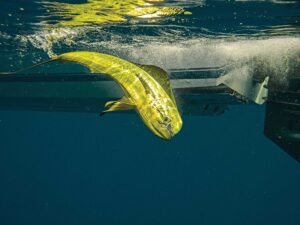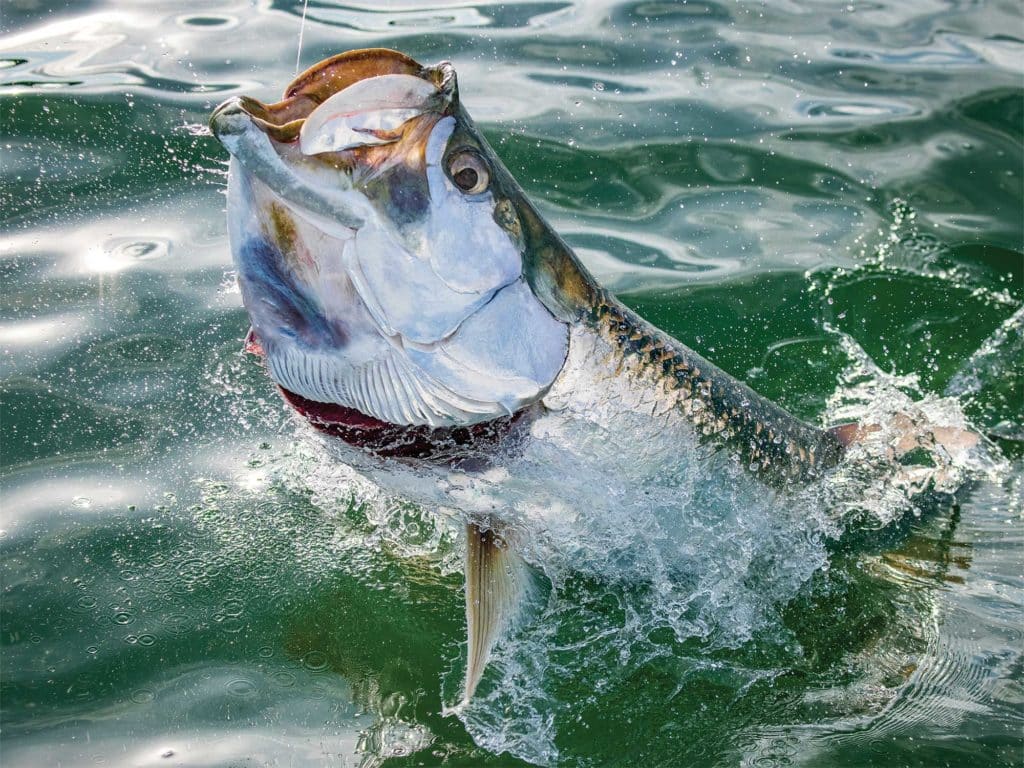
The cat is out of the bag. South Texas waters, once the best-kept secret in the tarpon fishing world, are getting increased attention from silver king chasers, many of whom now consider the Lone Star State a great alternative to Florida for testing their mettle against the formidable adversary with conventional or fly tackle.
Last summer was one to remember, according to Capt. Brian Barrera, who guides out of South Padre Island and led his clients to 66 catches of tarpon up to about 240 pounds, the most he has ever recorded in a single season.
“It was an incredible run, and a lot of the fish were big,” he says. “It’s not unusual to catch a lot of the smaller tarpon, but the big ones were here in good numbers last summer, even a few going over 200 pounds.”
Texas Hotspots
Tarpon fishing is good along the Texas coast most summers. Some of the best takes place around Galveston, but the jetties at Port O’Connor on the middle Texas coast provide reliable action during July, August and September. Most tarpon at the Port O’Connor jetties fall in the 40- to 50-pound range, while their Galveston counterparts are bigger, frequently in the 100-pound class or above.
Galveston tarpon guides primarily resort to trolling lures, like a Coon Pop, or fishing live mullet. Off the Port O’Connor jetties, your best bet is to fish live shrimp or croakers under a float. However, fly-fishing is a great option too. Just ease along the jetties with the trolling motor and look for tarpon rolling close to the rocks, where they forage for baitfish and shrimp.
Fly-fishing guide Tom Horbey says he spends quite a few days in August and September at the end of the Port O’Connor jetties, fishing slow-sinking streamers in the current. And while he dedicates much of the time during charters to sight-casting to rolling fish, Horbey also looks for tarpon in back bays, where he has encountered heavyweights in the 160- to 200-pound class the past few years.
South of Port O’Connor, the roughly 70-mile stretch from the Port Mansfield jetties on down to the South Padre Island jetties is where the finest tarpon fishing in Texas occurs. That’s precisely where Barrera concentrates his tarpon efforts during summer and early fall.
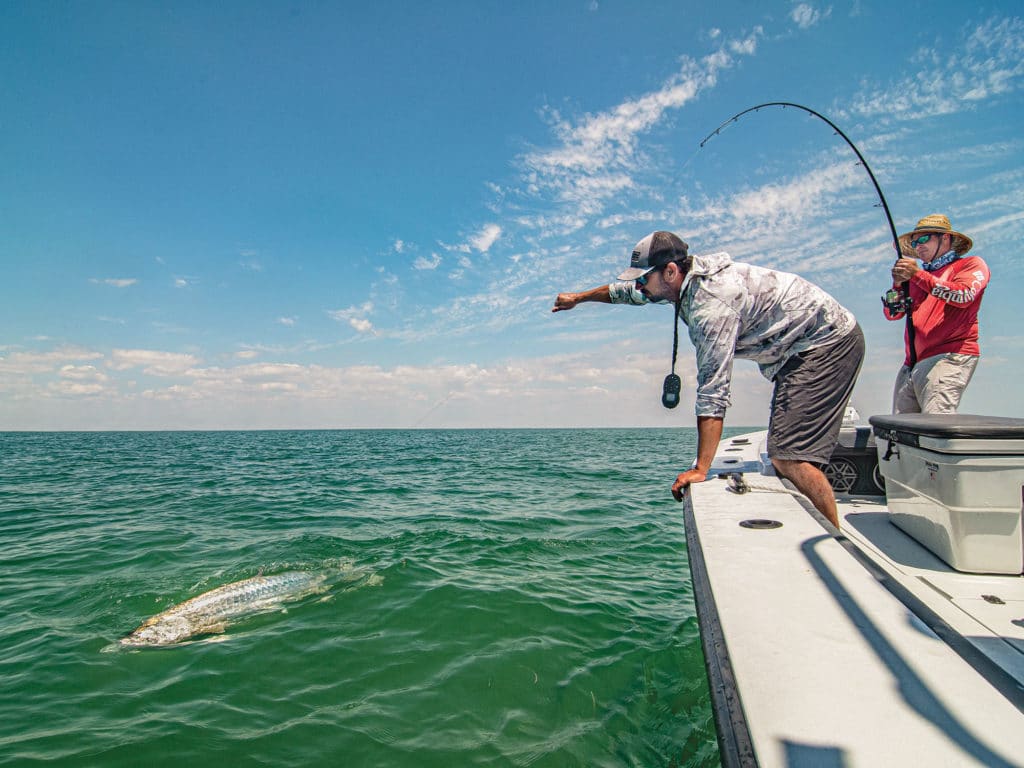
Search and Seizure
“On a typical day of fishing, I’ll work the jetties and the surf, if it’s calm,” Barrera says. “If we’ve got 2- to 3-foot seas, I can cover about 35 miles looking for tarpon. I’ll run the surf, then come back in the Intracoastal Waterway for a smoother ride.
“I’m constantly looking for signs of tarpon,” he says. “Diving birds are always good, but even if I see a single mullet jump, I’ll go to it. I also look with binoculars for the silver flash of rolling tarpon, and use my electronics to pinpoint them underwater.
“I like to move along the jetties with the trolling motor, using the side scan on my Humminbird Solex to find tarpon underwater. That allows me to locate the fish and stay with them as we troll or cast lures,” continues Barrera, who also stakes out or hits Spot-Lock on his Minn Kota to intercept schools.
The Migration
Longtime tarpon guide Capt. Tim O’Brien says the great tarpon fishing along South Padre Island began about six years ago. “The fish migrate from the Mississippi River Delta starting in March and April, and end up along South Padre Island for much of the summer and early fall. As the water temperature drops below 75 degrees, the tarpon move down south to Tampico and Veracruz, Mexico, some 340 miles away.”
O’Brien says the tarpon fishing will continue through October and sometimes into November, depending on how many cold fronts pass through the region early and how long the water temperature stays in the 70s.
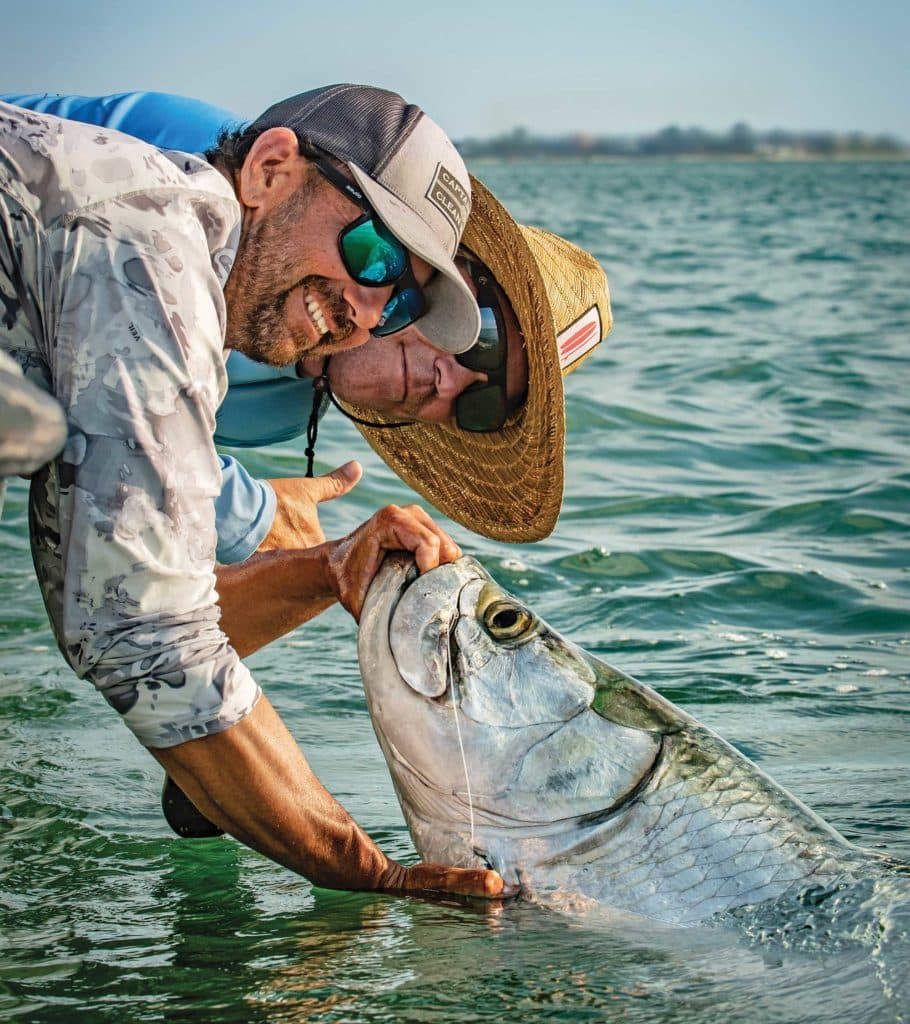
Baits and Rigging
At the peak of the tarpon run, Barrera fishes lures and both live and dead baits, mostly in the surf, in water about 20 feet deep. His preferred live baits for the jetties are pinfish—which can be caught in traps set out around boat docks—and live mullet procured along the jetties with a cast net. For dead baits, he likes ribbonfish and mullet.
Barrera fishes either live or dead baits on 4/0 to 13/0 circle hooks, depending on size, with 14 inches of fluorocarbon leader, 50- to 80-pound for the smaller tarpon, and 100- to 130-pound for the bigger fish. Thin wire hooks placed through the lips of a baitfish deliver the most hookups, he claims.
O’Brien favors artificials for conventional tackle, particularly 9- to 14-inch Hogy lures, and finds the best colors are black and white. “We rig them on swimbait-style jig heads,” he says, adding that the D.O.A. Bait Buster deep runner is another good lure. “We fish them on 30-pound Power Pro, with 2 to 3 feet of 60- to 100-pound leader tied to the braid with an FG knot.
“Another option is free-lining croakers, pinfish and live shrimp, or fish them under a cork,” explains O’Brien, who believes that, if you’re into big tarpon, big croakers rigged on a 7/0 hook are the best way to go.
Read Next: Fishing South Padre Island, Texas
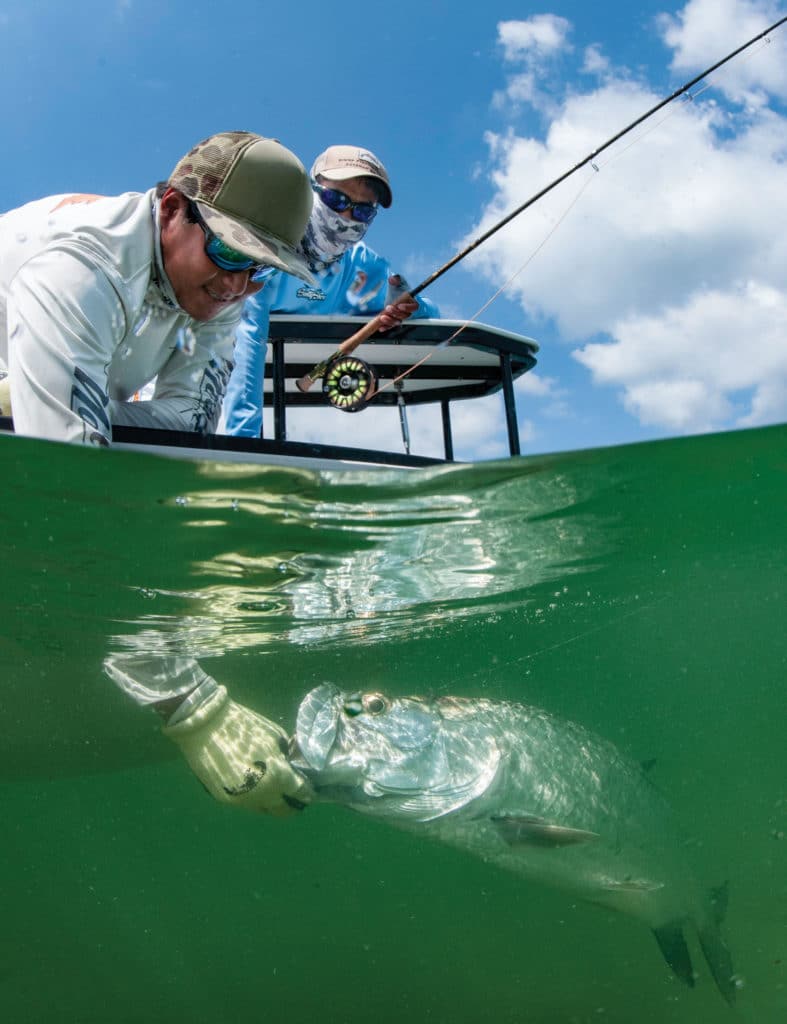
Fly Flinging
“On the other hand, it’s tough to beat sight-casting to these fish with a fly,” O’Brien says. “We use 10- to 12-weight rods and, since we often target rolling tarpon, the fly needs to be fished about 10 feet in front of the fish.
“For the most part, tarpon here weigh from 60 to 80 pounds, but we do have some big ones. My personal best weighed 180 pounds. I caught it on a Zonker (rabbit strip) fly while fishing the Port Mansfield jetties,” he says. “However, a giant weighing 212 pounds was caught on a Whistler fly off Boca Chica Beach, on the south side of the South Padre Island jetties, the general area where we scored 17 tarpon in one day, my best to date.”
One of the top tarpon fishing adventures of my life was with Capt. Eric Glass, a longtime fly and light-tackle guide in Laguna Madre, who says the granite jetties at Brazos Santiago Pass and East Cut are good places to try and jump some fish on fly. He prefers a 10- or 11-weight rod for the job.
Tarpon prowl the outskirts of large schools of scaled sardines, bay anchovies, gulf menhaden and herring gathering in the area. And the local fly-rodders have had consistent success at dawn and dusk casting 3- to 4-inch baitfish imitations tied on 1/0 to 3/0 hooks, always keeping an eye out for pods of rolling fish in the vicinity.
SWS Tackle Box: Spinning and Baitcasting
- Rods: Shimano 8-foot Teramar XX spinning and G.Loomis 7-foot heavy-action IMX Pro Blue baitcasting, or equivalents
- Lures: Coon Pop; Hogy Original 14-inch in black or white; D.O.A. Bait Buster in brown, root beer or glow, and TerrorEyz in root beer or glow
- Line: 80-pound braid and fluorocarbon leaders; 50- to 80-pound for smaller tarpon, and 100-to 130-pound for the large ones
- Reels: Shimano Saragosa 10000 spinning and Tranx 400 baitcasting, or equivalents
SWS Tackle Box: Fly-Fishing
- Rod: 9-foot, 10- to 12-weight
- Reel: Large arbor models with good drag and 250-yard capacity
- Line: Tarpon or saltwater taper in floating, intermediate or slow-sink, depending on the situation; tapered 9- to 12-foot leaders with 50- to 100-pound fluorocarbon bite tippet
- Flies: Hackle or rabbit-strip baitfish imitations in 3- to 5-inch sizes tied on 1/0 to 3/0 hooks

